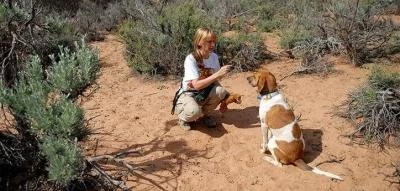
How to Teach a Dog to Sit in 3 Easy Steps
Teaching a dog to sit can be useful in instances where you need your dog to stop jumping on something (or someone) or to wait politely and safely, such as when you open a door or before crossing a street. It’s often much easier to give a dog a clear directive like “sit,” rather than just saying “no.” Plus, the “sit” command is easy to teach many dogs — even stubborn dogs. Follow these three easy steps to teach a dog to sit.
How to train a dog to sit
For this basic dog training plan, you’ll want to start practicing in a calm location. Have small treats on hand that your dog enjoys, as well as a clicker.

See how your community is doing
- The first step in teaching a dog to sit involves luring the dog into the position with a treat. Stand in front of your dog, and hold a treat between your thumb and index finger. Put your hand near the dog's nose (but don’t let the dog get the treat). Slowly move your hand up in front of the dog’s face and over the dog’s head. As their head goes up, their rear will go down. When the dog’s rear touches the ground, click your clicker and reward them with the treat. If your dog’s rear doesn’t go down, click and give the treat every time the dog’s head goes up to track the treat; eventually their rear should naturally start going down too. If your dog backs up without sitting, do the training with a wall or other barrier behind them.
- Once your dog is sitting quickly every time you practice step 1, add the cue “sit.” Continue with the lure and the additional “sit” until they are consistent.
- You’ll now phase out the lure by just offering the command “sit.” With consistent practice, you should be able to say “sit” and your dog will sit without needing the lure.
Proofing
Proofing in dog training means teaching the dog to generalize the behavior in different contexts, including in different locations and with different handlers. Only change one factor at a time — e.g., switch to a new handler but not to a new location yet. Have new handlers start with step 2 of the training process.
For new locations, start someplace with few distractions (e.g., your backyard), and then move to different spots with steadily increasing distractions until your dog will sit on cue no matter where you are. Practice with people — adults and kids — moving slowly around your dog and then more quickly, and practice around other dogs of various activity levels.
Always go at your dog’s pace. Keep training sessions short and fun, and take a break if you get stuck. Some dogs take longer than others to learn to sit, but with consistent practice you should be able to reach your goal.
